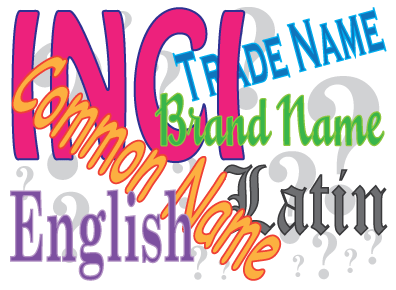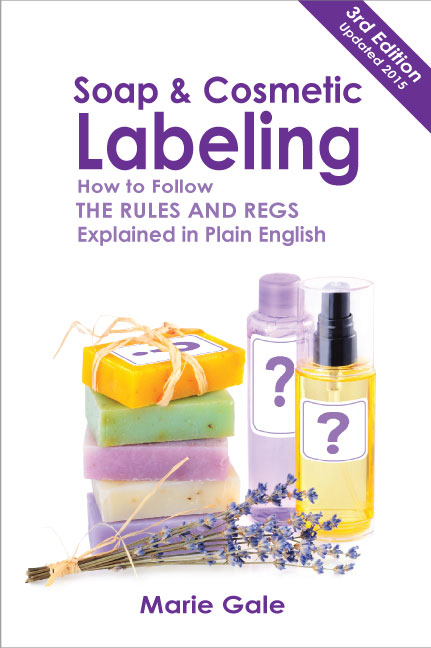The FDA has said that the “common name”1 is required for cosmetic ingredients.
But what does that mean, exactly?…
Let me tell you the story of the Cosmetic Ingredient Dictionary, and INCI names.
Once Upon a Time
Back in the 1970’s, a book called the Cosmetic Ingredient Dictionary (CID) was published by the Cosmetic Toiletries and Fragrance Association, a US trade association for the cosmetic industry. The CID listed the acceptable “common” (human understandable) names for cosmetic ingredients. Since it was a US publication, the plant-based (botanical) ingredients were listed by their common English names.
The FDA said that was a good place to get the names of the ingredients used in cosmetics for the newly required ingredient declaration.
Fast forward to 1995, and the face of the cosmetic industry was changing. Products were being manufactured and sold in multiple countries. The European Union was establishing regulations to cover multiple countries with multiple languages. To accomodate all the big players, a new edition of the CID was published which used the universal, multi-lingual Latin name to identify botanical ingredients. The EU accepted the CID as the International Nomenclature of Cosmetic Ingredients, the international standard for listing cosmetic ingredients (from whence we get the international “I” in “INCI”).
The CTFA (which eventually became the Personal Care Products Council) tried to get the FDA to accept the new edition of the CID as the standard, including the Latin names for botanicals; the FDA declined, saying (essentially) that the Latin name is not the common name for people in the US.2
However, the FDA has acknowledged that when it comes to non-botanical ingredients, the CID is typically the go-to source for the correct name to use.3 You want to know what your emulsifier or preservative is made of? The names used to describe those ingredients are typically the ones that have been approved for inclusion in the INCI; the place all cosmetic manufacturers go to get the ingredient names. It makes it much easier for consumers to read and understand ingredient declarations when everyone uses the same names.
So, where does that leave us now?
Trade Name or Brand Name
First of all, it’s not the “trade name” or the “brand name” of the ingredient. Just because you refer to your lye as “Red Devil” (and maybe it IS a red devil!) doesn’t mean that you should use that in your ingredient list. That’s not the common name. In that case, the common name is the correct chemical name, “sodium hydroxide.”
Generally, a cosmetic ingredient has a common name by which it is recognized, and that name is listed in the Cosmetic Ingredient Dictionary by its INCI name.
If the product is a blended ingredient, the supplier should be able to tell you the common (“INCI”) names for the components.
Chemical (Non-Botanical) Ingredients
The “common name” for chemical cosmetic ingredients (that is, they are not plant or botanical ingredients) is most often the name that is listed in the Cosmetic Ingredient Dictionary. That’s the name that all the cosmetic manufacturers use for that chemical, making it the common name that the consumer will understand.
Botanical Ingredients
For botanical ingredients, which are named from the plant they come from (such as olive oil, rose petals, cinnamon bark or shea butter) the name to use is determined by the country you are in.
Latin
Outside the United States, due to a multitude of languages and multi-lingual regulations, the general rule (required by most countries) is to use the Latin name, which is the one listed in the CID. By using the Latin name you can ensure that people of different languages can identify the exact plant source for the ingredient. Latin, as a standard for identifying botanicals is, indeed, “common” is most of these countries.
English
Inside the United States, however, the FDA has determined that the “common name” for plant-based ingredients is the English name. So in the US, the correct way to identify botanical ingredients is by their common English name.
The FDA has said that you may include the Latin name in parenthesis as a secondary name if you want, but it is not required.
More Info
For more information about how to identify ingredients in the ingredient declaration, see pages 100 – 108 in Soap and Cosmetic Labeling. (You can use the button below to purchase the book if you don’t already have it!)
- Ingredient Names, FDA Website. Also see 15 USC 1454(c)(3) ↩︎
- FDA Response to CTFA Petition Regarding Harmonization of Ingredient Labeling Names and Recognition of the International Cosmetic Ingredient Dictionary Sixth Edition ↩︎
- Current Issues in the Safety and Labeling of Cosmetics (video) by Linda Katz, FDA Office of Cosmetics and Colors ↩︎


Leave a Reply